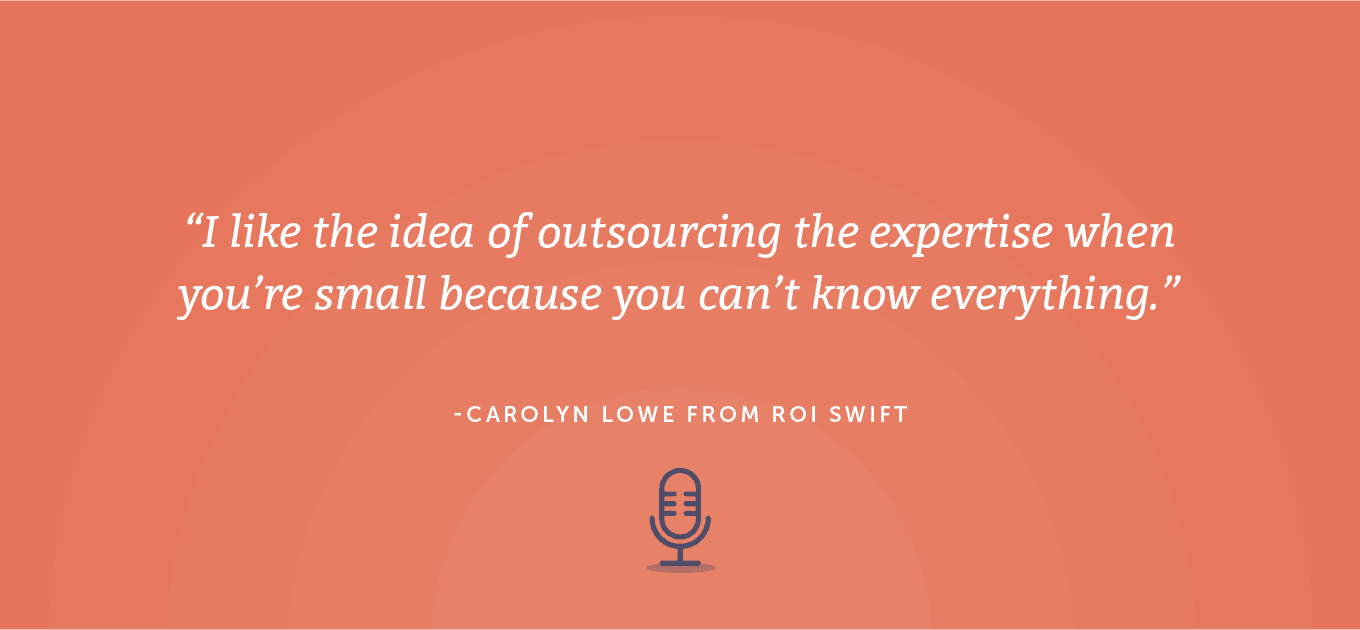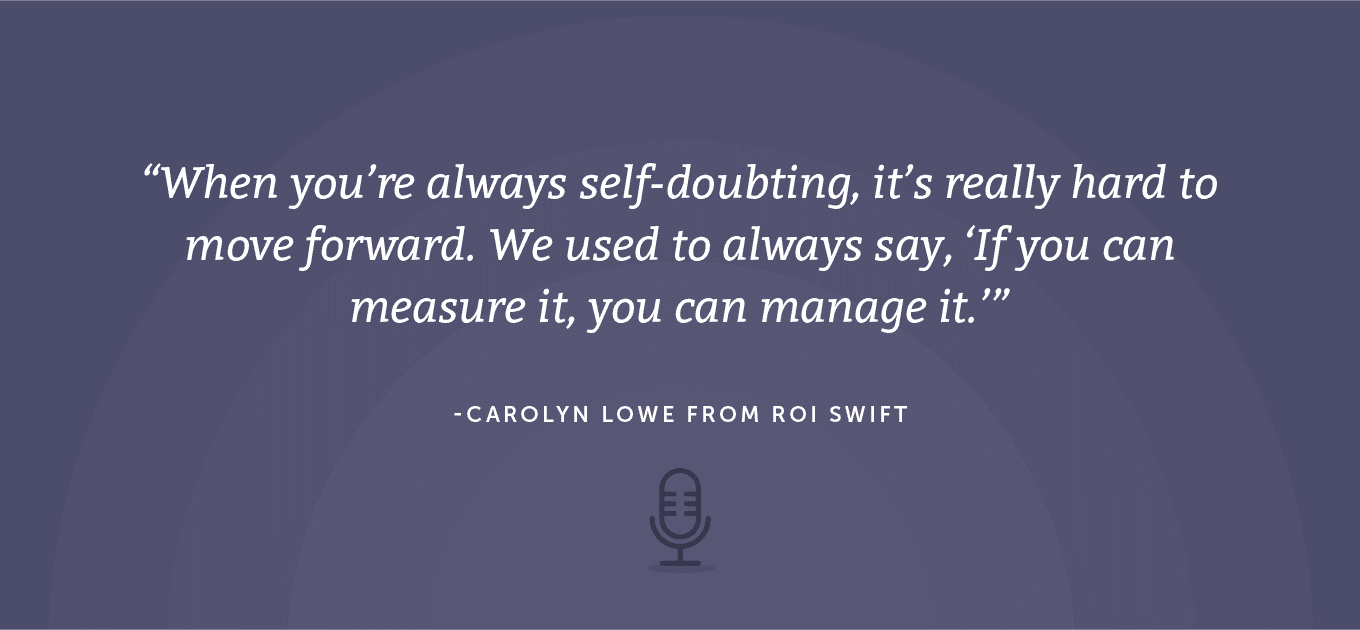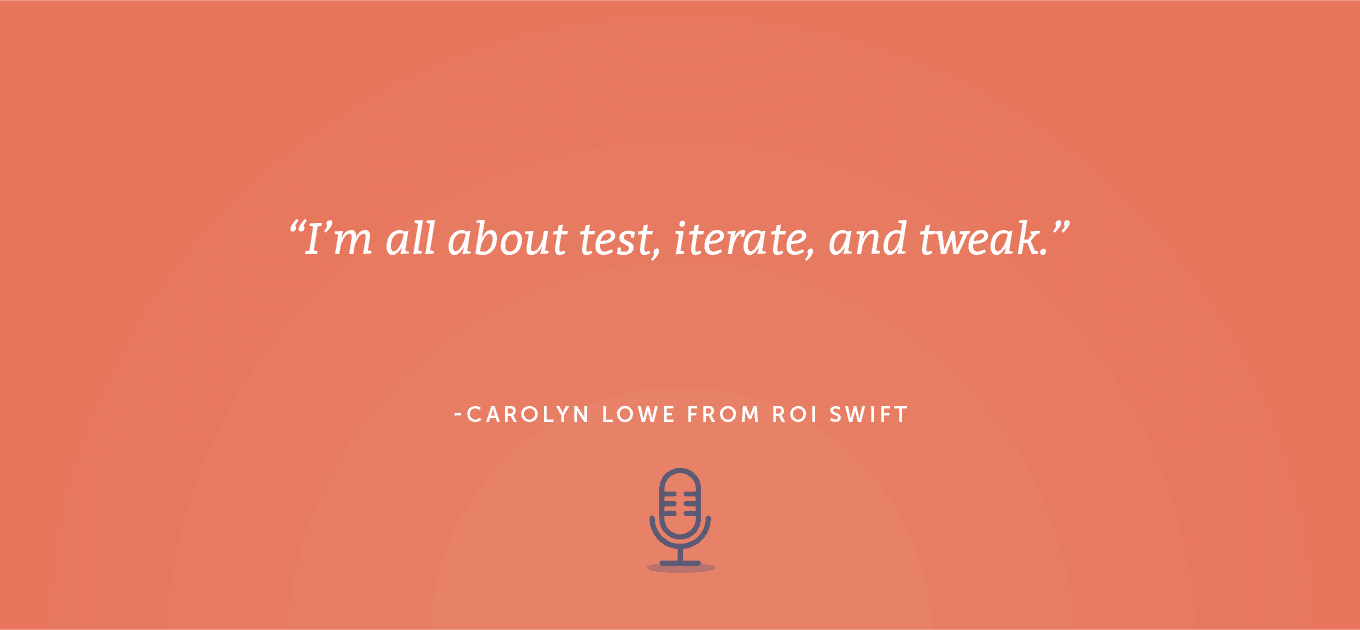Marketers struggle with the fear of focusing on the right things and doing things the wrong way. However, there are ways to use, gather, and apply data to get on the right path to generate a return.
Today’s guest is Carolyn Lowe, Founder and CEO at ROI Swift and author of Business Growth Do’s and Absolute Don’ts. Carolyn talks about how to use the right data to make the right decisions.
[podcast_motor_player]
Some of the highlights of the show include:
- Paid Platforms: Amazon, Facebook make a profit and ad dollars go up in flames
- Margins for Error: Marketers have more leeway at big businesses hiring experts
- Isolation vs. Network: Compare performance to know if you’re missing something
- Self-Doubt: Lack of confidence can corrode team’s ability to be successful
- eCommerce/Marketing Strategy: Test, iterate, tweak to measure and manage
- Business Growth Book: Get basics right and scale core values for positive path
- Brands: How are you different? Break through noise to sell a story, sell a product
- Quantitative/Qualitative Research: Get to know your customer base via surveys
- Best Metrics: Prove what marketers are doing is working or not to be profitable
Links:
- Carolyn Lowe on LinkedIn
- ROI Swift
- Business Growth Do’s and Absolute Don’ts
- Dell
- Chewy
- Ben Sailer on LinkedIn
- CoSchedule
If you liked today’s show, please subscribe on iTunes to The Actionable Content Marketing Podcast! The podcast is also available on SoundCloud, Stitcher, and Google Podcasts.
Quotes from Carolyn Lowe:
- “I like the idea of outsourcing the expertise when you’re small because you can’t know everything.”
- “When you’re always self-doubting, it’s really hard to move forward. We used to always say, ‘If you can measure it, you can manage it.’”
- “I’m all about test, iterate, and tweak.”
- “It starts and ends with the customer.”
[Tweet “How Marketers Can Know They’re On the Right Path With Carolyn Lowe From @RoiSwift”]
Transcript:
Ben: Hey, Carolyn. How’s it going today?
Carolyn: Great, Ben. How are you?
Ben: I’m not bad. Just pushing through the middle of the week here.
Carolyn: Me too.
Ben: Aren’t we all, really? I’m really excited about this conversation because we’re really going to speak to what I think is a really common problem that marketers face regardless of how much experience we have, regardless of what kind of organization or company we’re working for. But how can we know that we’re doing the “right things” or how do we make sure we’re on the correct path?
I think generally, marketers are smart people. Why do we second guess ourselves so much? Why is it that we so often ask whether what we’re doing is really the best thing we could be doing, are we doing things the right way, or why do we struggle to understand with confidence that we really are committed to the best course of action with our strategy, with our tactics, and with all the things that we do to help grow our organizations?
Carolyn: It’s a good question. It’s definitely a loaded question. At the end of the day, a lot of marketers are almost perfectionists in a way. They want to make sure that they’re doing the best that they can. When I was at Dell, I would have a $200 million marketing budget. It was a little easier to make mistakes. Oh, whoops, I made a mistake and maybe it costs $1000.
When you’re a $10 million or $20 million company, those little mistakes, you’re constantly want to make sure that you’re making the best use of every single one of those dollars because you’ve either gone out and raised that money, or you’ve bootstrapped that money and it’s definitely not something you want to light on fire.
Ben: Right. You don’t want to light it on fire, but unfortunately, it’s extremely easy (it turns out) to light money on fire. Very flammable, very combustible as it turns out.
Carolyn: And Zuckerberg makes it really easy to light your money on fire. I can’t even say Bezos anymore because he stepped down. But that’s really the thing that really drives me is that those platforms are not out to help you maximize. Amazon now makes more money on advertising than Home Depot and some of these other massive companies making profits. It is responsible for a bigger and bigger percentage of their revenue and it doesn’t come with a playbook. It’s really easy to make mistakes on a lot of marketing platforms.
Ben: I think it is, especially as it pertains to the paid channels, that the platform holders do not have your best interests at heart. I feel like at best, it’s more of a neutral sentiment toward the people who are actually spending the dollars to buy the ads because they’re also running their own business like you say. That’s how they’re making their profits from you trying to make your own. At best, it can be an uncomfortable relationship.
I think with regard to just maybe more broadly speaking, I think especially, we feel that kind of anxiety with our paid spends for a number of reasons. But in general and for all the reasons that you’ve outlined for why this is the case, we want to be perfectionists. We’re never quite as sure as we would like to be about what we’re doing. This phenomena or this issue, is this something that you’ve seen more amongst the marketers at large companies where maybe you’ve got, like you say, more leeway, or is it more common amongst marketers and startups where the margins for error are a bit more narrow?
Does it seem to just afflict everybody more or less equally? As marketers, is this just a part of our own human condition, almost kind of perpetually having that nagging doubtful voice in the back of our minds?
Carolyn: Yeah, I think it spreads across. I’ve worked with large private equity companies that are well funded, hundreds of millions of dollars, but you’d be surprised that even if they’ve got a marketing team, that marketing team can’t be experts in everything. I’ve seen a lot less of that at bigger companies where you can hire the experts. I see more of that, is there something I’m missing? What don’t I know? I see a lot more of that in small- to medium-sized businesses.
There was a business we were working with that was doing $30 million a year on Amazon. It’s not insignificant, but they had no idea how Amazon worked. That was shocking to me at $30 million. Every single piece of your business, that quickly adds up and that’s why I feel that these smaller and medium-sized businesses would do well to hire agencies in some cases because you can’t hire that $200,000 a year Facebook expert when you’re doing $3 billion. It just doesn’t work.
I like the idea of outsourcing the expertise when you’re small because you can’t know everything. That’s our model. We really help people grow and then they can hire those in-house experts. The other thing that I think is really hard when you’re sitting there by yourself, you’re in a consumer brand, and you’re thinking, well, what about this, should I be doing SMS, should I be doing Pinterest, should I be doing TikTok advertising?

You don’t have any benchmarks. You can’t look across the 50 different other companies that are doing it and see how your performance compares. I also feel like there’s a little bit of isolation if you’re within a small and medium business and you’re doing all the marketing yourself. Unless you have a really good network or a great Facebook group that you guys can bounce ideas off of, you never really know if you’re missing something.
Ben: Right. I think that there’s a great point there that you just touched on. If that is the situation that you’re in, an agency partner can be really valuable because they have the advantage of having a much broader perspective. When they’ve seen dozens, maybe hundreds of companies in the same situation, there’s just a perspective you get that way that you can’t really get if it’s just you and your team, your company, your customers, and it’s the situation that’s directly in front of you. I think that’s definitely something to consider.
If a marketing team is in this position where they’re just never quite sure if really what they’re doing is really what they actually should be doing, how can that lack of confidence really corrode that team’s ability to be successful?
Carolyn: I think that’s a great question. When you’re always self-doubting, it’s really hard to move forward. We used to always say, if you can measure it, you can manage it. That was our expression when I was at Dell. It was actually negative, which was if you can’t measure it, you can’t manage it.

I’m all about test, iterate, and tweak. I think that that has served me well over my 20 years in ecommerce and marketing. If you’re not sure, go out and grab a test budget. When I worked with a couple of different companies, one of them out on the west coast, it was a technology company, a big huge technology company, but they would carve out about 10% of their budget for these new initiatives, tests, or strategic.

They would actually report differently to Wall Street on that part of their business and so that way, it wouldn’t muck up their regular numbers. I like the idea of saying, hey, we’re going to carve off this strategic initiatives budget and we’re going to go try this. I always thought that was great because then Wall Street wouldn’t give them a hard time if their core business metrics suffered. So they always carved off a piece of that.
Also, a good strategy is to just be constantly testing and saying, we’re going to spend X amount of our budget on testing to know if we could be doing this better or we’re going to spend X amount on automation, innovation, or AI to see if we get better results. I’m all about testing, tweaking, and optimizing.
Ben: I think that that’s a great framework to just give yourself the space to just try things because then you get answers and then answers give you certainty one way or the other. You do that enough times you build confidence rather than just sitting and twiddling your thumbs, and just doing stuff but never really quite being sure about the things you’re doing. One of the first things that you talked about in your book after the introduction is really getting the basics right and scaling core values.
If marketers are trying to find their own true north, they’re trying to figure out what a positive direction looks like for them to move forward. Why does it make so much sense to start with simply understanding what your company’s core values are?
Carolyn: I think that this is critically important and people learn it a little bit too late. Company starts out one way and they value success and growth at all costs. Then people say, wait a minute, I don’t want to kill myself anymore, this isn’t an environment that I like. When you strip all that back there’s nothing there. Really, it comes down to the values of the company, and then that way you can make sure that you’re getting the right people.
For us, always be learning and caring about what you do are two of our four core values. What we realized was we sat down, we had these big sticky notes, and we said, okay, let’s talk about our A players. Every company has A players. Who are the people that you would be devastated if you lost?
Who are your best folks on the team? And then you start thinking about, what are the qualities of these people? Why are they such a great fit for our company? That’s how you figure out what your values are and that’s one way to do it. That’s how we do it.
I think it’s really important because then we ask interview questions on that. We’re looking for people who are humble, who have advanced stuff. One of our team members just built a whole custom data warehouse and reporting for Amazon that didn’t exist before. We’re all about supporting, how can we do things, how can we make it better, how can we always be learning? Because like you said, if you keep doing what you did, you’re going to get what you got.
One of our core values is we don’t want to do what we did. We want to do things better and differently. That really helps us determine who’s going to be happy at the company? Are these their core values? If they’re going to be happy at the company, we always ask in interviews, describe yourself and what are the three words that people would use to describe you? When people say helpful, honest, caring, or if they say, innovative, those are the words we’re looking for to really match up with our core values.
Ben: I think that’s a great explanation for why core values actually matter. With every company I’ve worked for, there’s always been an emphasis on core values. I think it’s maybe a bit more common within tech-centric type companies than some others. It’s really easy, I think, to look at core values as this being a plaque that’s on the wall or just something that’s hollow, but I suppose they are if you treat them that way.
I just really love the way that you open up the book pretty much just laying out why they’re important. It matters because I feel like they’re very easy. It’s something that’s very easy for people to overlook.
Carolyn: It guides everything you do. One of Costco’s, they’ve got four or five. One of their top ones is to take care of our employees and take care of our customers are in the top three, right? If everybody in the company knows, hey, I’m going to get rewarded, this is what the company cares about. They care about taking care of customers. Costco has got some of the best customer service, you can return anything anytime.
I’ve seen people return a turkey the day after Thanksgiving, which is the wrapping and Costco gives them their money back. I feel like that permeates how your employees act. If you look at the flip side of that, the airlines, you could tell that customers are not one of the first things they think about. Sometimes it’s shareholders, sometimes it’s maximizing profit.
I think a lot of them are coming around to, oh, yeah, we really got to care about and take care of the customer. I think in any service business, you’ve got to have some customer core value driving what you do, or else people are going to choose other things over the customer first.
Ben: What Carolyn says about core values is super important. They’re something that’s easy to overlook or to not take seriously. But when they’re thoughtfully crafted and routinely applied, they can really change the trajectory of a team or even an entire company.
If you can apply the right data to your work in alignment with the right values, you can really supercharge your results in a way that you can feel confident about without questioning whether you’re doing the right things correctly or whether you’re doing things in a way that suboptimal because the fact that you’re on the right track will show in your results. Now back to Carolyn.
Once marketers firmly understand their organization’s mission, the organization’s core values, presuming that the company has those things in place, if they don’t, then there might be some issues that a marketing team is going to have to either struggle with or try to work around maybe one way or another. But let’s assume the company has these things, and the marketing team has made it a priority to align their work with that mission, with those core values. What’s their next step for figuring out what they should do next, figuring out the right way to move forward, the right strategy, the right tactics, or whatever the case may be?
Carolyn: I hate to go back to this, but I think it starts and ends with the customer. I always ask, when brands come to us and they want us to work with them, I always say, how are you different in 11 words or less? If they go on and on and they can’t answer that question, that’s where I start to really wonder, how are you different? Can you articulate this? What is your core mission? What is your core why?

There was a boot company that I worked with, Cowboy Boots footwear and apparel. They said, we are high-quality, handmade boots at an honest price. They basically said, you shouldn’t have to pay twice as much for a high-quality handmade pair of boots. I was like, great, I can get behind that. I can get behind that message.
It’s a very crowded space in places like beauty. What is your core differentiator? How are you different? How are you going to break through the noise? I really like to start there. How are you different? Because you can’t tell a story, you can’t sell a product if you don’t know who you are.
Ben: I think it makes so much sense though. Everything that a business does really is ultimately about customers most of the time, or at least it probably should be.
Carolyn: It should be.
Ben: When you think about it that way, when you’re trying to bridge the gap between what customers need and what your company’s mission is, marketing almost becomes a means of connecting those two things to one another.
If you start with the customer and you work your way backward, that starts to slowly answer a lot of questions that you might have about what kind of messaging is going to resonate, where do you need to be present in order to reach those people? What should that message even be so that you’re portraying your organization honestly or you’re honestly framing your core value proposition?
I think that’s awesome. I don’t think there’s any issue whatsoever with harping on the need to put customers first because it seems obvious when you break it down the way that you have. But I don’t know that it necessarily always seems obvious day-to-day in the work that we’re all doing when we’re caught up in other things.
Carolyn: Totally, and I think a lot of folks get so caught up in research, segmentation, and all of this, but then they don’t realize they’re sitting on top of this great resource, which is their existing customer base. So if you’ve been in business for more than a year, people are like, I’m trying to figure out who my customer is and what my demographic is. I said, why don’t you just survey them?
I did a quantitative and qualitative research project about 12 years ago for people who had bought and I surveyed all 30,000 of their customers. Then I did qualitative interviews with about 50 different customer segments and I learned a ton. I learned that they had had an early product quality, I learned that there was a win-back opportunity. I feel like marketers sometimes get caught up so much in the data that they forget to have conversations.
This brand I worked with realized a year after they were formed that they could make a real connection with customers. They started writing handwritten notes, like handwritten thank you notes when somebody purchased. Imagine that, when you buy something from Amazon, do you get a handwritten note from the CEO of the company? No, you get it delivered in a brown box. I think brands like Chewy have done a really good job differentiating themselves based on the customer experience.
Ben: Yeah, 100%. The last question I’ll throw your way. You’re talking about measurement and just the simple reality that you can’t manage what you can’t measure, which I think makes a lot of sense. The answer to this is going to be very context sensitive because it’s going to depend on what type of business, what types of tactics are executing and so forth. But just in terms of laying out a process, how can marketers identify the best metrics for them or the best KPIs for them that’ll help prove or disprove that what they’re doing either is or isn’t working?
Carolyn: It depends on what area you’re working on. I work largely in paid so I’ll start with paid. It’s gotten a lot more complicated since iOS 14. Thank you very much for that, Tim Cook. We look at things like marketing as a percent of revenue. Every business, you have that baseline number. How much am I spending versus my total revenue?
You think back to the days of TV when 20 years ago, you couldn’t measure TV ads at all. They just said, okay, we’re going to use X percent of our budget on TV ads. We would like to think that we have evolved, but I think you really need to look at, okay, I’m going to spend X percent, here’s where I can be profitable. If my cost of goods is 30%, I’ve got 70% after that. I’ve got maybe 5% headcount, I can afford to spend maybe 50%, to acquire that customer on the first time, depending on if it’s a repeat purchase consumable versus a one-time purchase ongoing subscription base type.
Really figuring out how much you can afford to spend and then really looking at the profitability by channel, although you’ve lost a lot of those signals. There’s a couple of really interesting hacks, like good old-fashioned send all your ads to one landing page that’s hidden that nobody else can find and then you can measure true metrics on that. When I was at Dell, when we did some television advertising, we would do in-market advertising so that we would only do Chicago and Dallas. We would look at sales in those pre and post.
It’s really hard these days to get to, I spent $1 on Facebook and I got $3.50 back. It’s getting really hard to do that down to that level, but I think there are ways around it through custom landing pages and sending traffic to certain places where you can measure it better. There are some software programs too that help as well that you can add on. I think gone are the days where you can say, well, $1 on Google is this and $1 on Facebook gets me that.
We have to be a little more holistic in our marketing approach. You can still do optimizations within a platform, but I think we’re really focusing much more on the marketing efficiency ratio than on individual platform metrics these days.
Ben: I think that makes a lot of sense. Carolyn, thanks so much for coming on the show and for sharing your insight with all of us. Hopefully, people can leave this conversation maybe feeling like they have a little bit better idea of how to erase some of that ambiguity just from their marketing practice.
Carolyn: And most of all, know that they’re not alone. We’re all on this boat together.
Ben: Yes, absolutely. Thank you.

The post How Marketers Can Know They’re On the Right Path With Carolyn Lowe From ROI Swift [AMP 254] appeared first on CoSchedule Blog.

![You are currently viewing How Marketers Can Know They’re On the Right Path With Carolyn Lowe From ROI Swift [AMP 254]](https://www.dimaservices.agency/wp-content/uploads/2021/09/254_Carolyn-Lowe-Podcast-Graphics_header.png)


